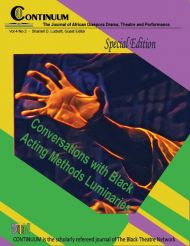 Urban Bush Women Thirtieth Anniversary Tour
Urban Bush Women Thirtieth Anniversary Tour
University of Georgia Fine Arts Theatre
January 24, 2015
Visioning Partner: Jawole Willa Jo Zollar
Managing Partner: Nathea Lee
Producing Partner: Jonathan Secor
Composer/Musician: George Caldwell
Lighting Disigners: Susan Hamburger, Russell Sandifer
Costume Disigners: Naoko Nagata, Omotayo Wunmi Olaiya
Costume Constructor: Zinda Lee Williams
Sound Designer: Daniel Smith
Dramaturg: Talvin Wilks
Dancers:
Du’Bois A’Keen
Amanda Castro
Courtney J. Cook
Chanon Judson
Tendayi Kuumba
Stephanie Mas
Samantha Speis
Urban Bush Women Thirtieth Anniversary Tour
Visioning Partner: Jawole Willa Jo Zollar
University of Georgia Fine Arts Theatre, Athens
24 January 2015
It is hard to believe that thirty years have passed since Jawole Willa Jo Zollar founded the iconic dance/performance company Urban Bush Women. Today she carries the title Visioning Partner, and her vision is as vibrant and socially aware as ever. Since 1984 the company has been fulfilling its mission to combine cutting-edge modern choreography with community engagement. Its home base is Brooklyn, New York, but the company’s dance programs and workshops have been seen and experienced all over the world.
Zollar, who was born in Kansas City, Missouri, holds a BA in dance from the University of Missouri and an MFA in dance from Florida State University. However, it may be her experiences as a former student of Katherine Dunham and Dianne McIntyre that helped shaped her vision of dance as an instrument for “cultural organizing and civic engagement,” as she stated in the program biography. Zollar currently teaches at Florida State University and directs the UBW Summer Institute that, among other programs, trains facilitators to travel nationally and internationally to conduct workshops that explore the histories of local communities through performance.
In “Hep Hep Sweet Sweet,” the first piece on the program at the Fine Arts Theatre at the University of Georgia, Zollar conceived and choreographed “a place of memory, rumor, myths and dreams” from her own past: the Kansas City that her parents lived in. Through the music of Charlie Parker, Count Basie, Scrapper Blackwell, Dinah Washington, and the Dirty Dozen Brass Band, with additional live music by George Caldwell, Zollar chronicles the hope that fueled their migration from the South, the frustration and pain of dreams thwarted and deferred, the release offered through music and dance in the nightclubs, and the resilience of survivors. The dancers continually reconfigured the space through the moving of chairs. Some of the dancers sang, revealing beautiful voices that complemented the movement. They danced through the blues, through swing, through jazz, through a history that was personal, cultural, and universal. Talvin Wilks, a highly regarded playwright, director, and dramaturg is credited as the dramaturg for this composition, which is marked by humor as well as heartbreak.
There was a change in the program that Zollar announced herself. “The Dark Swan,” Zollar’s connection between Russian classical ballet and contemporary dance as well as a celebration of “my mother/African/Black women who refuse to wither away and die or die beautifully,” was replaced with “Give Your Hands to the Struggle,” a solo performance that put me in mind of the indelible Alvin Ailey composition, “Cry.” Unlike “Cry,” which is a more abstractly, though deeply felt exploration of a woman’s journey through suffering toward triumph of the spirit, “Give Your Hands to the Struggle,” a section of the longer work “Hands Singing Song,” was choreographed by Zollar to pay tribute to leaders and martyrs of the Civil Rights Movement. The names Medgar Evers and Rosa Parks are among those spoken aloud in the score, as well as the names of iconic dancer/choreographers Pearl Primus and Katherine Dunham. Included in the litany of names are those of Trayvon Martin and other victims of authorized killing. Zollar identified the brilliant speech by the late Adam Clayton Powell Jr., “What’s In Your Hands,” as the inspiration for this dance, which was supported by the music of Berneice Johnson Reagon.
The intermission was followed by a longer composition, “Walking with ‘Trane,’ Chapter 2,” choreographed by Zollar, dancer Samantha Speis, and the company. Much of the musical score was played live by composer/musician George Caldwell, giving a surprising added sense of depth to the piece as dancers and musician appeared to be working off of one another in a similar manner to the way a musician supports a singer. The “Trane,” of course, is John Coltrane, and the dance worked its way into the spirituality of his music through Caldwell’s original composition, inspired primarily by Coltrane’s “A Love Supreme.” The dancers, which included one male dancer, who was not featured, but simply incorporated into the ensemble, wore grey costumes reminiscent of a cloudy day in the city. At one point in the dance, the dancers chanted and sang. I heard portions of the Twenty-third Psalm. Some of their movements appeared to illustrate what Ntozake Shange describes as combat breath, resistance to spiritual containment.
Thirty years of life has not diminished the inspirational power of Urban Bush Woman, nor that of the founder, Jawole Willa Jo Zollar. Here’s to thirty more years.
Freda Scott Giles
Associate Professor Emerita
University of Georgia



